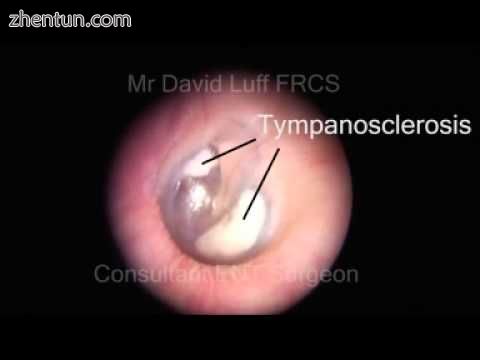鼓膜硬化是由于TM和中耳的上皮下结缔组织透明化和随后钙化引起的病症,有时会对听力产生不利影响[1] [2]。

目录
1 分类
2 症状和体征
3 原因
4 病理生理学
5 诊断
6 治疗
7 预后
8 流行病学
9 参考
分类
肾上腺硬化指的是仅在鼓膜内的钙化,并且通常不如鼓室内鼓室硬化症那么广泛,鼓室内鼓室硬化是指中耳内的任何其他位置,例如听骨链,中耳粘膜或较少见的乳突腔。[3]
迹象和症状
白细胞硬化很少引起任何症状。[3] 另一方面,鼓室硬化可导致中耳或鼓膜上显著的听力损失[3]或白色斑块。[1]
原因
对鼓室硬化的病因尚未广泛了解。有几个可能的因素可能导致出现这种情况,包括:
长期中耳炎(或“胶耳”)[2]
插入鼓膜造口管。[4] [5] [6]如果抽吸是作为插入的一部分进行的,则发生鼓室硬化的风险会增加。[7]如果使用更大的管,[8]或重复该过程,风险也会增加。[9]
动脉粥样硬化[10]
关于胆脂瘤是否与鼓室硬化有关,目前正在进行研究。如果存在关联,则这两个条件可能共存。[2]
病理生理学
成纤维细胞活性增加导致胶原蛋白沉积。然后在鼓膜的固有层中形成磷酸钙斑块。[1] [2]
诊断
如果病变是典型的,非广泛的并且对听力没有损害,则很少需要对病情进行调查。听力测定用于确定听力损失的程度,如果有的话。[3]鼓室图测量产生鼓室图,当存在鼓室硬化时,鼓室图可能不同。[11]计算机断层扫描(CT)可用于确定中耳是否存在疾病。[12]虽然听力丧失是许多耳疾病的常见症状,例如耳硬化症(耳中骨骼生长异常),[3]鼓膜上的白色,白斑块是鼓室硬化症的相当特征。胆脂瘤的外观相似,但白度是在鼓膜后面,而不是在内部。[引证需要]
治疗
助听器是听力损失障碍的常见治疗方法。更具体的治疗是外科手术,包括切除硬化区域,然后进一步修复听骨链。有几种技术,有时涉及两次手术; [2] [13]成功率是可变的。[14] [15] [16]外科手术对内耳的损伤是一个可能和严重的问题,因为它可能导致感觉神经性耳聋。[17]
预测
在大多数情况下,鼓膜硬化症在最初的疾病发作后十年内不会引起任何可识别的听力损失。[5] [18] 3年后,硬化变化似乎趋于稳定,但未解决或消失。[9] [19]
流行病学
白细胞减少症似乎比鼓室硬化症更常见。[2] 大多数研究尚未针对一般健康人群进行,而是针对患有中耳炎或患有先前手术中的鼓膜造口术的患者。 在所研究的患有“胶耳”且接受过鼓膜造孔术治疗的儿童中,有23-40%的患者患有鼓室硬化症。[4] [9] [20] [21] 一项研究表明,患有动脉粥样硬化的人比其他健康人更容易患有鼓室硬化症。[10]
参考:
Forséni M, Bagger-Sjöbäck D, Hultcrantz M (May 2001). "A study of inflammatory mediators in the human tympanosclerotic middle ear". Archives of Otolaryngology–Head & Neck Surgery. 127 (5): 559–64. doi:10.1001/archotol.127.5.559. PMID 11346433. Retrieved 2010-01-26.[permanent dead link]
Asiri S, Hasham A, al Anazy F, Zakzouk S, Banjar A (December 1999). "Tympanosclerosis: review of literature and incidence among patients with middle-ear infection". The Journal of Laryngology and Otology. 113 (12): 1076–80. doi:10.1017/s0022215100157937. PMID 10767919.
Isaacson JE, Vora NM (September 2003). "Differential diagnosis and treatment of hearing loss". American Family Physician. 68 (6): 1125–32. PMID 14524400.
Kay DJ, Nelson M, Rosenfeld RM (April 2001). "Meta-analysis of tympanostomy tube sequelae". Otolaryngology–Head and Neck Surgery. 124 (4): 374–80. doi:10.1067/mhn.2001.113941. PMID 11283489. Retrieved 2010-01-26.
Johnston LC, Feldman HM, Paradise JL, et al. (July 2004). "Tympanic membrane abnormalities and hearing levels at the ages of 5 and 6 years in relation to persistent otitis media and tympanostomy tube insertion in the first 3 years of life: a prospective study incorporating a randomized clinical trial". Pediatrics. 114 (1): e58–67. doi:10.1542/peds.114.1.e58. PMID 15231974. Retrieved 2010-01-26.
Browning, George G.; Rovers, Maroeska M.; Williamson, Ian; Lous, Jørgen; Burton, Martin J. (2010-10-06). "Grommets (ventilation tubes) for hearing loss associated with otitis media with effusion in children". The Cochrane Database of Systematic Reviews (10): CD001801. doi:10.1002/14651858.CD001801.pub3. ISSN 1469-493X. PMID 20927726.
McRae D, Gatland DJ, Youngs R, Cook J (August 1989). "Aspiration of middle ear effusions prior to grommet insertion an etiological factor in tympanosclerosis". The Journal of Otolaryngology. 18 (5): 229–31. PMID 2769837.
Hampal S, Flood LM, Kumar BU (March 1991). "The mini-grommet and tympanosclerosis". The Journal of Laryngology and Otology. 105 (3): 161–4. doi:10.1017/s0022215100115269. PMID 2019798.
Maw AR (August 1991). "Development of tympanosclerosis in children with otitis media with effusion and ventilation tubes". The Journal of Laryngology and Otology. 105 (8): 614–7. doi:10.1017/s0022215100116822. PMID 1919311.
Ferri M, Faggioli GL, Ferri GG, Pirodda A (June 2004). "Is carotid stenosis correlated with tympanosclerosis". International Angiology : A Journal of the International Union of Angiology. 23 (2): 144–6. PMID 15507892. Retrieved 2010-01-26.
Onusko E (November 2004). "Tympanometry". American Family Physician. 70 (9): 1713–20. PMID 15554489.
Swartz JD, Goodman RS, Russell KB, Marlowe FI, Wolfson RJ (August 1983). "High-resolution computed tomography of the middle ear and mastoid. Part II: Tubotympanic disease". Radiology. 148 (2): 455–9. doi:10.1148/radiology.148.2.6867342. PMID 6867342. Retrieved 2010-01-26.
Bayazit YA, Ozer E, Kara C, Gökpinar S, Kanlikama M, Mumbuç S (May 2004). "An analysis of the single-stage tympanoplasty with over-underlay grafting in tympanosclerosis". Otology & Neurotology. 25 (3): 211–4. doi:10.1097/00129492-200405000-00001. PMID 15129093. Retrieved 2010-01-26.
Vincent R, Oates J, Sperling NM (November 2002). "Stapedotomy for tympanosclerotic stapes fixation: is it safe and efficient? A review of 68 cases". Otology & Neurotology. 23 (6): 866–72. doi:10.1097/00129492-200211000-00010. PMID 12438848. Retrieved 2010-01-26.
Albu S, Babighian G, Trabalzini F (September 2000). "Surgical treatment of tympanosclerosis". The American Journal of Otology. 21 (5): 631–5. PMID 10993449.
Teufert KB, De La Cruz A (March 2002). "Tympanosclerosis: long-term hearing results after ossicular reconstruction". Otolaryngology–Head and Neck Surgery. 126 (3): 264–72. doi:10.1067/mhn.2002.122701. PMID 11956534. Retrieved 2010-01-26.
Bellucci RJ (August 1985). "Cochlear hearing loss in tympanoplasty". Otolaryngology–Head and Neck Surgery. 93 (4): 482–5. doi:10.1177/019459988509300403. PMID 3931022.
Riley DN, Herberger S, McBride G, Law K (March 1997). "Myringotomy and ventilation tube insertion: a ten-year follow-up". The Journal of Laryngology and Otology. 111 (3): 257–61. doi:10.1017/s0022215100137016. PMID 9156062.
De Beer BA, Schilder AG, Zielhuis GA, Graamans K (September 2005). "Natural course of tympanic membrane pathology related to otitis media and ventilation tubes between ages 8 and 18 years". Otology & Neurotology. 26 (5): 1016–21. doi:10.1097/01.mao.0000185058.89586.ed. PMID 16151352. Retrieved 2010-01-26.
Pereira MB, Pereira DR, Costa SS (2005). "Tympanostomy tube sequelae in children with otitis media with effusion: a three-year follow-up study". Brazilian Journal of Otorhinolaryngology. 71 (4): 415–20. doi:10.1590/S0034-72992005000400003. PMID 16446953. Retrieved 2010-01-26.
Schilder AG, Zielhuis GA, Haggard MP, van den Broek P (May 1995). "Long-term effects of otitis media with effusion: otomicroscopic findings". The American Journal of Otology. 16 (3): 365–72. PMID 8588632. |